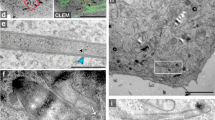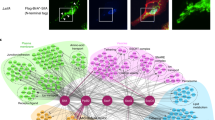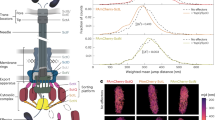Abstract
The type-III secretion system (T3SS) enables gram-negative bacteria to inject effector proteins into eukaryotic host cells. Upon entry, T3SS effectors work cooperatively to reprogram host cells, enabling bacterial survival. Progress in understanding when and where effectors localize in host cells has been hindered by a dearth of tools to study these proteins in the native cellular environment. We report a method to label and track T3SS effectors during infection using a split-GFP system. We demonstrate this technique by labeling three effectors from Salmonella enterica (PipB2, SteA and SteC) and characterizing their localization in host cells. PipB2 displayed highly dynamic behavior on tubules emanating from the Salmonella-containing vacuole labeled with both endo- and exocytic markers. SteA was preferentially enriched on tubules localizing with Golgi markers. This segregation suggests that effector targeting and localization may have a functional role during infection.
This is a preview of subscription content, access via your institution
Access options
Subscribe to this journal
Receive 12 print issues and online access
$259.00 per year
only $21.58 per issue
Buy this article
- Purchase on Springer Link
- Instant access to full article PDF
Prices may be subject to local taxes which are calculated during checkout






Similar content being viewed by others
References
Johnson, S., Deane, J.E. & Lea, S.M. The type III needle and the damage done. Curr. Opin. Struct. Biol. 15, 700–707 (2005).
Steele-Mortimer, O. The Salmonella-containing vacuole: moving with the times. Curr. Opin. Microbiol. 11, 38–45 (2008).
Galan, J.E. Common themes in the design and function of bacterial effectors. Cell Host Microbe 5, 571–579 (2009).
Patel, J.C., Hueffer, K., Lam, T.T. & Galan, J.E. Diversification of a Salmonella virulence protein function by ubiquitin-dependent differential localization. Cell 137, 283–294 (2009).
Boucrot, E., Beuzon, C.R., Holden, D.W., Gorvel, J.P. & Meresse, S. Salmonella typhimurium SifA effector protein requires its membrane-anchoring C-terminal hexapeptide for its biological function. J. Biol. Chem. 278, 14196–14202 (2003).
Reinicke, A.T. et al. A Salmonella typhimurium effector protein SifA is modified by host cell prenylation and S-acylation machinery. J. Biol. Chem. 280, 14620–14627 (2005).
Bakowski, M.A., Cirulis, J.T., Brown, N.F., Finlay, B.B. & Brumell, J.H. SopD acts cooperatively with SopB during Salmonella enterica serovar Typhimurium invasion. Cell. Microbiol. 9, 2839–2855 (2007).
Drecktrah, D. et al. Dynamic behavior of Salmonella-induced membrane tubules in epithelial cells. Traffic 9, 2117–2129 (2008).
Akeda, Y. & Galan, J.E. Chaperone release and unfolding of substrates in type III secretion. Nature 437, 911–915 (2005).
Van Engelenburg, S.B. & Palmer, A.E. Quantification of real-time Salmonella effector type III secretion kinetics reveals differential secretion rates for SopE2 and SptP. Chem. Biol. 15, 619–628 (2008).
Enninga, J., Mounier, J., Sansonetti, P. & Tran Van Nhieu, G. Secretion of type III effectors into host cells in real time. Nat. Methods 2, 959–965 (2005).
Schlumberger, M.C. et al. Real-time imaging of type III secretion: Salmonella SipA injection into host cells. Proc. Natl. Acad. Sci. USA 102, 12548–12553 (2005).
Sory, M.P. & Cornelis, G.R. Translocation of a hybrid YopE-adenylate cyclase from Yersinia enterocolitica into HeLa cells. Mol. Microbiol. 14, 583–594 (1994).
Garcia, J.T. et al. Measurement of effector protein injection by type III and type IV secretion systems by using a 13-residue phosphorylatable glycogen synthase kinase tag. Infect. Immun. 74, 5645–5657 (2006).
Cabantous, S., Terwilliger, T.C. & Waldo, G.S. Protein tagging and detection with engineered self-assembling fragments of green fluorescent protein. Nat. Biotechnol. 23, 102–107 (2005).
Henry, T. et al. The Salmonella effector protein PipB2 is a linker for kinesin-1. Proc. Natl. Acad. Sci. USA 103, 13497–13502 (2006).
Boucrot, E., Henry, T., Borg, J.P., Gorvel, J.P. & Meresse, S. The intracellular fate of Salmonella depends on the recruitment of kinesin. Science 308, 1174–1178 (2005).
Knodler, L.A. & Steele-Mortimer, O. The Salmonella effector PipB2 affects late endosome/lysosome distribution to mediate Sif extension. Mol. Biol. Cell 16, 4108–4123 (2005).
Szeto, J., Namolovan, A., Osborne, S.E., Coombes, B.K. & Brumell, J.H. Salmonella-containing vacuoles display centrifugal movement associated with cell-to-cell transfer in epithelial cells. Infect. Immun. 77, 996–1007 (2009).
Geddes, K., Worley, M., Niemann, G. & Heffron, F. Identification of new secreted effectors in Salmonella enterica serovar Typhimurium. Infect. Immun. 73, 6260–6271 (2005).
Poh, J. et al. SteC is a Salmonella kinase required for SPI-2-dependent F-actin remodelling. Cell. Microbiol. 10, 20–30 (2008).
Rajashekar, R., Liebl, D., Seitz, A. & Hensel, M. Dynamic remodeling of the endosomal system during formation of Salmonella-induced filaments by intracellular Salmonella enterica. Traffic 9, 2100–2116 (2008).
Beuzon, C.R. et al. Salmonella maintains the integrity of its intracellular vacuole through the action of SifA. EMBO J. 19, 3235–3249 (2000).
Knodler, L.A. et al. Salmonella type III effectors PipB and PipB2 are targeted to detergent-resistant microdomains on internal host cell membranes. Mol. Microbiol. 49, 685–704 (2003).
Brawn, L.C., Hayward, R.D. & Koronakis, V. Salmonella SPI1 effector SipA persists after entry and cooperates with a SPI2 effector to regulate phagosome maturation and intracellular replication. Cell Host Microbe 1, 63–75 (2007).
Humphreys, D., Hume, P.J. & Koronakis, V. The Salmonella effector SptP dephosphorylates host AAA+ ATPase VCP to promote development of its intracellular replicative niche. Cell Host Microbe 5, 225–233 (2009).
Haraga, A. & Miller, S.I. A Salmonella enterica serovar typhimurium translocated leucine-rich repeat effector protein inhibits NF-kappa B–dependent gene expression. Infect. Immun. 71, 4052–4058 (2003).
Mota, L.J., Ramsden, A.E., Liu, M., Castle, J.D. & Holden, D.W. SCAMP3 is a component of the Salmonella-induced tubular network and reveals an interaction between bacterial effectors and post-Golgi trafficking. Cell. Microbiol. 11, 1236–1253 (2009).
Prescott, A.R., Lucocq, J.M., James, J., Lister, J.M. & Ponnambalam, S. Distinct compartmentalization of TGN46 and beta 1,4-galactosyltransferase in HeLa cells. Eur. J. Cell Biol. 72, 238–246 (1997).
Datsenko, K.A. & Wanner, B.L. One-step inactivation of chromosomal genes in Escherichia coli K-12 using PCR products. Proc. Natl. Acad. Sci. USA 97, 6640–6645 (2000).
Zaal, K.J. et al. Golgi membranes are absorbed into and reemerge from the ER during mitosis. Cell 99, 589–601 (1999).
Uzzau, S., Figueroa-Bossi, N., Rubino, S. & Bossi, L. Epitope tagging of chromosomal genes in Salmonella. Proc. Natl. Acad. Sci. USA 98, 15264–15269 (2001).
Coombes, B.K., Brown, N.F., Valdez, Y., Brumell, J.H. & Finlay, B.B. Expression and secretion of Salmonella pathogenicity island-2 virulence genes in response to acidification exhibit differential requirements of a functional type III secretion apparatus and SsaL. J. Biol. Chem. 279, 49804–49815 (2004).
Uzzau, S., Figueroa-Bossi, N., Rubino, S. & Bossi, L. Epitope tagging of chromosomal genes in Salmonella. Proc. Natl. Acad. Sci. USA 98, 15264–15269 (2001).
Nakamura, K. et al. Transiently increased colocalization of vesicular glutamate transporters 1 and 2 at single axon terminals during postnatal development of mouse neocortex: a quantitative analysis with correlation coefficient. Eur. J. Neurosci. 26, 3054–3067 (2007).
Collazo, C.M. & Galan, J.E. Requirement for exported proteins in secretion through the invasion-associated type III system of Salmonella typhimurium. Infect. Immun. 64, 3524–3531 (1996).
Martin, B.R., Giepmans, B.N., Adams, S.R. & Tsien, R.Y. Mammalian cell-based optimization of the biarsenical-binding tetracysteine motif for improved fluorescence and affinity. Nat. Biotechnol. 23, 1308–1314 (2005).
Acknowledgements
We thank C. Detweiler (University of Colorado) for careful review of the manuscript and for providing Salmonella strains. Plasmids pKD46 pKD3, and pKD4 were obtained from B. Wanner (Purdue University) by means of C. Detweiler (University of Colorado). We acknowledge the Creative Training in Molecular Biology grant (US National Institutes of Health 5 T32GM07135-33) and the University of Colorado for financial support.
Author information
Authors and Affiliations
Contributions
S.B.V. and A.E.P. designed research; S.B.V. performed research; S.B.V. and A.E.P. analyzed data; S.B.V. and A.E.P. wrote the manuscript.
Corresponding author
Ethics declarations
Competing interests
The authors declare no competing financial interests.
Supplementary information
Supplementary Text and Figures
Supplementary Figures 1–10 (PDF 1213 kb)
Supplementary Movie 1
Ectopically expressed PipB2 GFPGFPcomp in the absence of all Salmonella effectors shows distinct dynamics within HeLa cells when compared to T3SS introduced PipB2 GFPcomp. HeLa cells were transiently transfected with PipB2-GFP11 and GFP1–10. PipB2 GFPcomp shows a steady state distribution at the cell periphery and perinuclear region. Image sequence was acquired 48 h after transfection. Images were acquired every 15 s and movie displayed at 10 FPS. Scale bar, 10 μm. (MOV 177 kb)
Supplementary Movie 2
PipB2 GFPcomp protein displays dynamic behavior in the context of the entire effector subset. PipB2-GFP11 SL1344 Salmonella-infected HeLa cell transiently expressing GFP1–10. PipB2 GFPcomp localizes with the SCV (center) and labels highly dynamic tubules protruding from this compartment. Images were acquired at 16 h after infection (MOI = 50). Images were acquired every 10 s and movie displayed at 10 FPS. Scale bar, 10 μm. (MOV 1090 kb)
Supplementary Movie 3
PipB2 GFPcomp dynamics are recapitulated in Salmonella-infected RAW264.7 macrophage-like cells. RAW264.7 cells were transduced with GFP1–10 and infected with PipB2-GFP11 expressing Salmonella. PipB2 GFPcomp (green) localized with intracellular Salmonella (red) and labels dynamic tubules. Images were acquired at 14 h after infection and 48 h after transduction (MOI = 20). Images were acquired every 10 s and movie displayed at 12.5 FPS. Scale bar, 10 μm. (MOV 111 kb)
Supplementary Movie 4
PipB2 GFPcomp highlights transient and destabilized tubules in the absence of the T3SS effector SifA. GFP1–10 expressing HeLa cells were infected with PipB2-GFP11 SL1344 Salmonella null for sifA. Image sequence was acquired at 16 h after infection (MOI = 50). Images were acquired every 10 s and movie displayed at 7 FPS. Scale bar, 10 μm. (MOV 902 kb)
Supplementary Movie 5
PipB2 GFPcomp displays dynamic behavior that is not always recapitulated by the fluid-phase endocytic tracer Alexa Fluor 595–dextran. GFP1–10 expressing HeLa cells infected with PipB2-GFP11 SL1344 Salmonella (18 h after infection; MOI = 50) were pulsed with Alexa Fluor 595–extran for 24 h to label all endocytic compartments. Notice that there is very little movement of the dextran-positive vesicles in the infected cell whereas there is rapid movement in the non-infected cells. We believe this is a consequence of the fact that Salmonella seizes membrane/endocytic cargo as an infection proceeds, which gives rise to a reduction in the number of endocytic vesicles and a reduction in the motility of Salmonella-induced tubules/endocytic membranes as has been previously reported8,22. Alexa Fluor 595–dextran tracer (top, red) and PipB2 GFPcomp (bottom, green). Images were acquired every 10 s and movie displayed at 30 FPS. (MOV 1142 kb)
Supplementary Movie 6
Tubulated PipB2 GFPcomp tubules are observed which do not localize with the late-endosomal/lysosomal marker LAMP1-mCherry. PipB2-GFP11 SL1344 infected HeLa cells transiently expressing GFP1–10 and LAMP1-mCherry were imaged 16 h after infection. PipB2 GFPcomp (top, green) and LAMP1-mCherry (bottom, magenta). Images were acquired every 15 s and movie displayed at 30 FPS. (MOV 1798 kb)
Supplementary Movie 7
SteA GFPcomp tubules exclude the late-endosomal/lysosomal marker LAMP1-mCherry. GFP1–10 and LAMP1-mCherry expressing HeLa cells infected with SteA-GFP11 SL1344 were imaged at 14 h after infection (MOI = 50). LAMP1-mCherry (magenta), SteA GFPcomp (green), and overlay (white). Images were acquired every 10 s and movie displayed at 10 FPS. Scale bar, 10 μm. (MOV 155 kb)
Rights and permissions
About this article
Cite this article
Van Engelenburg, S., Palmer, A. Imaging type-III secretion reveals dynamics and spatial segregation of Salmonella effectors. Nat Methods 7, 325–330 (2010). https://doi.org/10.1038/nmeth.1437
Received:
Accepted:
Published:
Issue Date:
DOI: https://doi.org/10.1038/nmeth.1437
This article is cited by
-
Single molecule analyses reveal dynamics of Salmonella translocated effector proteins in host cell endomembranes
Nature Communications (2023)
-
Intracellular delivery of protein drugs with an autonomously lysing bacterial system reduces tumor growth and metastases
Nature Communications (2021)
-
Doppler imaging detects bacterial infection of living tissue
Communications Biology (2021)
-
Engineering an efficient and bright split Corynactis californica green fluorescent protein
Scientific Reports (2021)
-
Multiplexed labeling of cellular proteins with split fluorescent protein tags
Communications Biology (2021)



